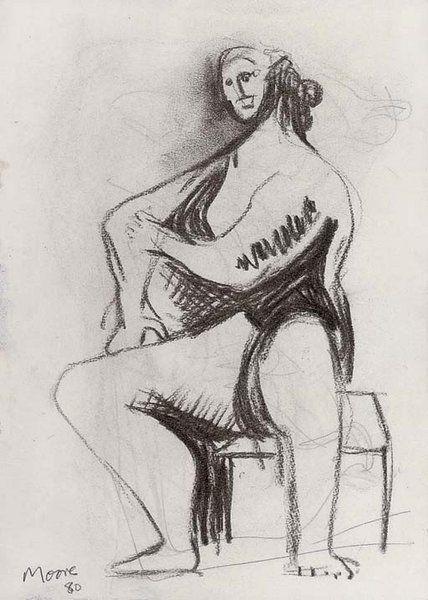Seated Nude
10642
HENRY MOORE, O.M., C.H.
(1898-1986)
Seated Nude
Watercolour,chalk on Bockingham white wove pencil and charcoal
HENRY MOORE (1898-1986)
Moore was born in Castleford, Yorkshire in 1898, the seventh of eight children. Aged twelve, he won a scholarship to Castleford Grammar School and despite his wish to attend art school he relinquished the idea at his parent's insistence, and became a teacher at his old school. World War I swiftly stalled his teaching career, as in February 1917 aged 18, he joined the army. Moore was injured in a gas attack at the Battle of Cambrai in November 1917 and excused from further active service. After the war, he received an ex-serviceman's grant to continue his education and in 1919 he became the first student of sculpture at Leeds School of Art, where began his long friendship with fellow student Barbara Hepworth. In 1921 Moore won a scholarship to study at the Royal College of Art, London, where Hepworth had gone the year before. A six-month RCA travelling scholarship allowed him to visit Italy in 1925 and Paris, where he met Picasso, Giacometti, Ernst and Breton. On his return he began a seven year post as Instructor of Sculpture at the RCA, teaching two days a week so he could continue his own work. Moore's early 1920s sculptures display the influences of both pre-Colombian art, an interest he had derived from his introduction at Leeds to primitive and tribal sculpture, and the Italian Renaissance masters he had viewed during his travels.
Moore held his first his solo show in 1928 and was subsequently recommended by the noted sculptor Jacob Epstein to London Underground, who then commissioned Moore to create a sculpture for their new London headquarters. In 1929, Moore married Irina Radetsky a painting student from the RCA and they moved to Hampstead, where they socialised within a group of aspiring and innovative artists that included Ben Nicholson, Barbara Hepworth, Naum Gabo, Roland Penrose and the art critic Herbert Read, the latter helping to publicise the artists' ideas and works. From the 1930s Moore and other artists from this group began to produce increasingly abstract work, rounded and curved forms, pierced with holes, moulded with hollows and with voids joined by string or wire. Moore's signature form at this time, the Reclining Figure, and the 'Mother and Child' were to re-appear throughout his career, alongside his Family Groups and Figure studies. Similarly the present work from 1980 is prefigured in elements of Moore's 1930 alabaster sculpture, Seated Figure.
Soon after the outbreak of World War II, Moore stopped executing sculptures and employed as a war artist he created beautifully haunting Shelter drawings of people sleeping in the London Underground tube stations while trying to protect themselves from the Blitz. Although he had received criticism for his earlier work these drawings attracted much public attention to Moore's work. In 1946 he made his first visit to America where a retrospective exhibition of his work was held at the Museum of Modern Art, New York and in 1948 he won the International Sculpture prize at the Venice Biennale. Moore began to execute increasingly prestigious commissions, such as Reclining Figure, 1956-58, for the UNESCO Building, Paris and in 1963 he was awarded the British Order of Merit.
Moore returned to drawing in 1968, after his seventieth birthday. The female form, which had arisen in his work in the 1920s continued to appear frequently in his later body of work, as displayed by the present drawing, but in a slightly different guise from earlier depictions. As Susan Compton states in her essay, Drawing & Sculpture, from the 1988 Henry Moore exhibition catalogue for the Royal Academy, 'The eighties mark a time when woman finds the need to restore to herself some of the gentleness,...a quality that Moore had often denied her in the work of his earlier years. At the end of his life he was able in part to return it to her..she became for him more human than goddess..she still remained an archetype'.
In 1978 the Arts Council organized an exhibition of Moore's work at the Serpentine Galley and at this time he gifted a number of his sculptures to the Tate Gallery. Moore died at his home in Much Hadham, Herts in 1986 and in 2000 Moore Square was opened on the site of his Castleford birthplace.
Pencil & charcoal
British
Royal Shakespeare Company. Henry Moore Foundation, 1987.
A. Garrould, C. Benicasa (Ed.), Moore, Rome, 1983, pl. 14. A. Garrould (Ed.), Henry Moore Complete Drawings 1977-81 , Volume 5, London, 1998, , p. 125, no. AG 80.205, HMF 80 (163), illustrated.











